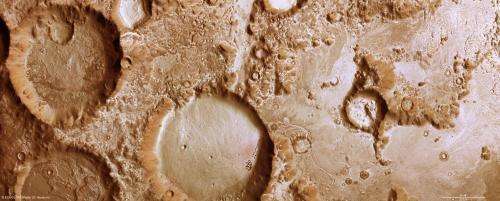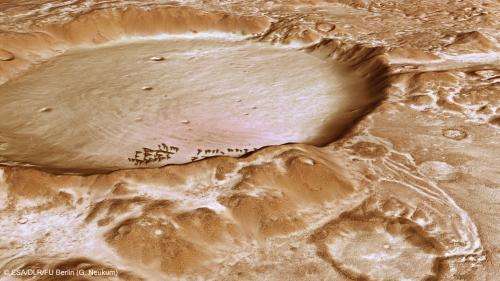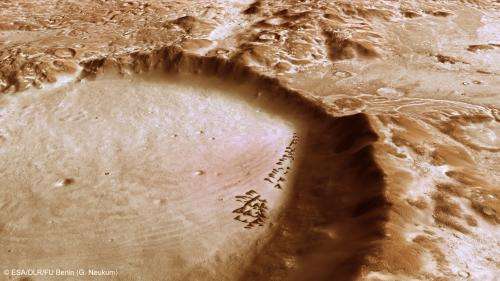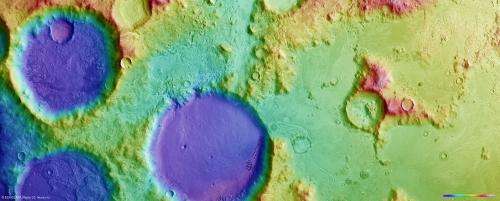High-Resolution Stereo Camera (HRSC) nadir and colour channel data taken during revolution 10778 on 18 June 2012 by ESA’s Mars Express have been combined to form a natural-colour view of Charitum Montes. Centred at around 53°S and 334°E, the image has a ground resolution of about 20 m per pixel. The heavily cratered region in this image is at the edge of the almost 1000 km long mountain range, which itself wraps around the boundary of the Argyre impact basin, the second largest on Mars. Credits: ESA/DLR/FU Berlin (G. Neukum)
(Phys.org)—The high-resolution stereo camera on ESA's Mars Express imaged the Charitum Montes region of the Red Planet on 18 June, near to Gale crater and the Argyre basin featured in our October and November image releases.
The brighter features, giving the image an ethereal winter-like feel in the colour images, are surfaces covered with seasonal carbon dioxide frost.
Charitum Montes are a large group of rugged mountains extending over almost 1000 km and bounding the southernmost rim of the Argyre impact basin.
They can be seen from Earth through larger telescope and were named by Eugène Michel Antoniadi (1870–1944) in his 1929 work La Planète Mars.
This computer-generated perspective view of Charitum Montes was created using data obtained from the High-Resolution Stereo Camera (HRSC) on ESA’s Mars Express. Centred at around 53°S and 334°E, the image has a ground resolution of about 20 m per pixel. The image shows the large breach in the northern wall of the crater, located near to the uppermost sand dune. The dusting of carbon dioxide ice is a seasonal feature in this region, which covers the crater floor and the surrounding plains. Credits: ESA/DLR/FU Berlin (G. Neukum)
The images here all show the region's old and highly-sculpted terrain, pockmarked with many large craters, all of which have been substantially filled in. The whole region is dusted with brighter carbon dioxide frost.
Numerous smaller 'pedestal craters' can also be seen in the 3D and 2D images. These are impact craters where the ejecta have formed a higher relief above the surroundings. One striking example is visible on the smooth plain to the lower right in the annotated image (Box A).
The ejecta surrounding pedestal craters form erosion-resistant layers, meaning that the immediate vicinity around the crater erodes more slowly than the surrounding terrain. The resistant ejecta layer is largely untouched, forming the pedestal.
Another well-preserved example of a pedestal feature surrounding an impact crater can be seen within the large, old and heavily-degraded crater on the lower-left side of the annotated image (Box B).
This computer-generated perspective view of Charitum Montes was created using data obtained from the High-Resolution Stereo Camera (HRSC) on ESA’s Mars Express. Centred at around 53°S and 334°E, the image has a ground resolution of about 20 m per pixel. The image shows the large breach in the northern wall of the crater, located near to the uppermost sand dune. The dusting of carbon dioxide ice is a seasonal feature in this region, which covers the crater floor and the surrounding plains. Credits: ESA/DLR/FU Berlin (G. Neukum)
In the centre of the 2D images and dominating the perspective images is a crater some 50 km wide filled with thick sedimentary deposits.
These deposits appear to have been introduced through one of several breaches in the northern crater rim (Box C in the annotated image).
Dendritic channels appear to emanate from a completely filled-in crater in this region (Box D), at the periphery of the large crater's northern edge.
Within the large crater, near to where the breach (C) in the crater wall occurred, though unconnected to this event, we can also see a small dune field (Box E).
This colour-coded overhead view is based on an ESA Mars Express HRSC digital terrain model of the region, from which the topography of the landscape can be derived. The colour coding shows the very edge of the Charitum Montes mountain region at the top of the image, with the highest elevation, while the subtle pedestal craters that dot the image almost fade away with just a small amount of relief difference between the elevated ejecta and the surrounding area. Centred at around 53°S and 334°E, the image has a ground resolution of about 20 m per pixel. The image was taken during revolution 10778 on 18 June 2012. Credits: ESA/DLR/FU Berlin (G. Neukum)
A region of significant interest to scientists lies within the large crater towards the top left of the first image (Box F). This crater shows a diverse range of filling material, with layers of varying colour and texture.
The uppermost layer appears to be bright and smooth, taking on the appearance of a relatively thin blanket with some impact craters.
This layer interfaces with the underlying darker layer via some very sharply defined edges, possibly as a result of erosion.
The underlying darker material has a much rougher and mottled appearance, and planetary geologists are still studying possible causes.
To the left of the crater interior, another layer of sediments clearly sets itself apart from the underlying strata, partly forming flat-topped structures (Box G).
The complexity and diversity of some areas in this winter wonderland would doubtless give Father Christmas a hard time in finding somewhere safe to land, but images like these are giving planetary geologists yet another fascinating region of the Red Planet to study.
Provided by European Space Agency



























